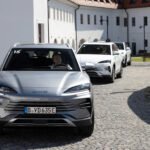In a groundbreaking development, Horse, the engine-making joint venture of Geely and the Renault Group, has unveiled a hybrid powertrain that can be retrofitted into electric cars. The innovative design integrates the internal combustion engine, electric motor, gearbox, and related electronics into a single unit that can easily fit into the same space as an EV’s main drive motor. This means that manufacturers can upgrade an electric vehicle with this unit without the need for extensive re-engineering or setting up a new production line.
One of the key features of this hybrid powertrain is its versatility in terms of fuel options. It can be fueled using petrol, E85 ethanol-petrol mix, pure methanol, and synthetic fuels, providing flexibility and sustainability. The powertrain can function both as a traditional parallel hybrid, powering the wheels directly, and as a range-extender, generating electricity for the drive motor.
Installation of the Horse unit is straightforward as it bolts directly into a car’s subframe. While it is primarily designed to replace the front motor in an EV, it can also be utilized in ICE car platforms, showcasing its adaptability across different vehicle types. This innovation comes at a time when several manufacturers are reevaluating their transition to all-electric line-ups.
Notably, Fiat is currently working on a new version of the 500e retrofitted with a hybrid powertrain to replace the old petrol 500 and boost sales amid slower EV adoption. Horse Powertrain CEO Matias Giannini emphasized the shift towards a technology-neutral world, where various markets and applications are pursuing sustainable mobility in their unique ways. The hybrid unit from Horse enables OEMs to offer powertrain diversity with minimal disruption to production processes and resource expenditure.
The unveiling of this hybrid powertrain signifies a new chapter in the automotive industry, where hybrid solutions play a crucial role in achieving sustainability goals. With Horse leading the way in innovative powertrain solutions, the future of mobility is set to become more diverse and eco-friendly.







